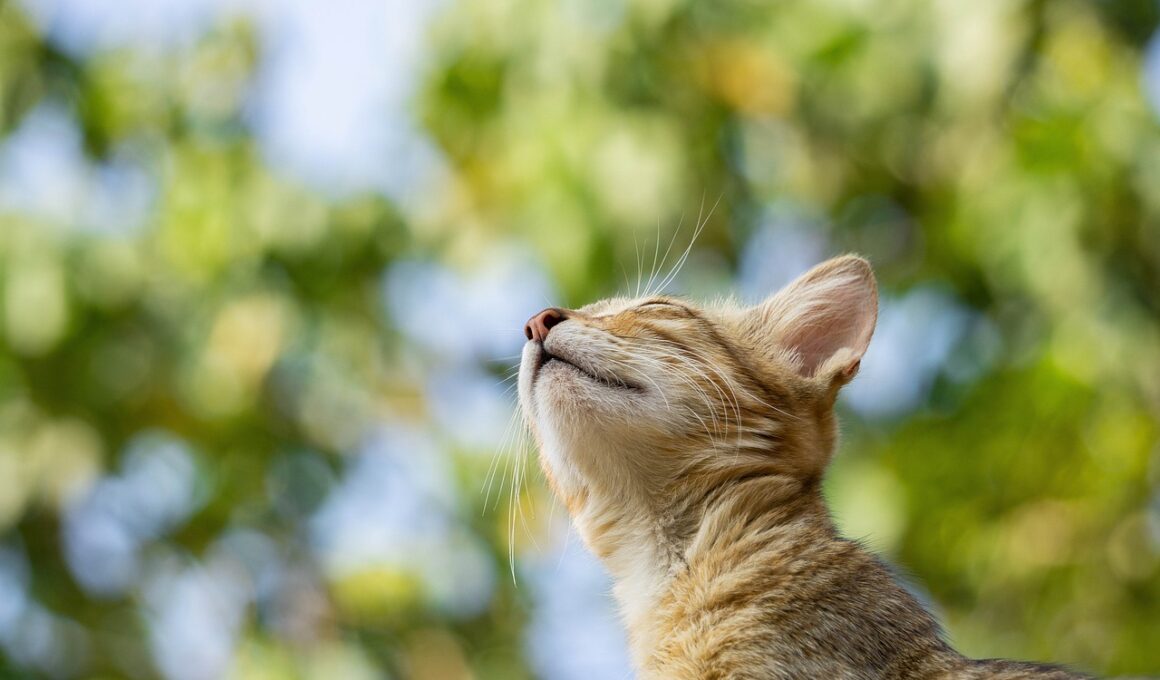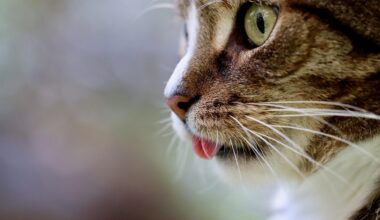Understanding Feline Hyperesthesia Syndrome
Feline Hyperesthesia Syndrome (FHS) is a complex and often perplexing disorder that can affect cats. The condition is characterized by heightened sensitivity to touch and other sensory stimuli. It typically manifests through strange behaviors that may alarm owners, such as excessive grooming, sudden bouts of energy, and even strange tail chasing. Most commonly observed in younger cats, especially those under two years old, the precise cause remains elusive to veterinarians and researchers. Some speculate genetic predispositions may contribute, while others suggest environmental factors such as stress might play a role. The symptoms can vary significantly between individual cats, making diagnosis challenging. While it can be uncommon and misidentified as other cat behavioral issues, recognizing FHS early can lead to effective management solutions. Owners are encouraged to take notes on their cat’s behavior to aid their veterinarian in diagnosing this syndrome. Since understanding the full spectrum of symptoms is crucial, educating oneself on FHS allows cat owners to make informed decisions about their pet’s health and behavior management strategies. Increased awareness can lead to timely interventions, improving the overall wellbeing for the affected felines.
Recognizing Common Symptoms
Symptoms of Feline Hyperesthesia Syndrome can be quite diverse, thus requiring attentiveness from cat owners. Some common indicators of FHS include excessive grooming, often resulting in patches of bare skin, twitching of the skin along the back, and unusual bursts of energy where the cat may appear agitated or frantic. Cats may also exhibit sudden aggression to touch or petting, where they will react defensively when brushed or petted. This unusual behavior can sometimes be mistaken for normal feline quirks, but the level of sensitivity is far beyond typical reactions. Another symptom might be what many refer to as “the crazy cat syndrome,” involving wild running or jumping without apparent external stimuli. This hyperactive behavior can lead to injuries or accidents around the home. Furthermore, vigilant owners may observe vocalizations such as yowling and meowing, indicating discomfort or distress. These symptoms can worsen during times of stress, such as changes in the home environment. Understanding these symptoms allows for early intervention, which is paramount for the comfort and health of any feline suffering from FHS.
Diagnosis of Feline Hyperesthesia Syndrome
Diagnosing Feline Hyperesthesia Syndrome encompasses a comprehensive approach, typically initiated during a visit to the veterinarian. Initially, veterinary professionals will conduct a thorough physical examination to rule out other feline health issues. Symptoms can overlap with various diseases, thus requiring careful observation and analysis. Blood tests may be ordered to exclude medical conditions such as allergies, skin diseases, or neurological disorders. It’s essential for owners to provide detailed behavioral histories and incident reports to aid the veterinarian’s diagnostic process. A holistic evaluation often includes assessing the cat’s environment, social interactions, and any recent changes that could contribute to anxiety or stress. Once other diagnoses have been ruled out, your veterinarian may conclude that symptoms align with FHS. Often, they may recommend behavioral modifications accompanied by treatment approaches tailored specifically to the individual cat’s needs. Each diagnosis plays a significant role in establishing an effective treatment plan, which is critical in assuring the quality of life for both the pet and its owner. Continuous monitoring and follow-up are vital components to ensure the chosen treatment is efficacious.
Treatment Options for Feline Hyperesthesia Syndrome
Treatment for Feline Hyperesthesia Syndrome needs to be tailored to the specific needs and behaviors presented by the cat. Veterinarians may recommend behavioral modification strategies that help mitigate anxiety and encourage a calmer demeanor. Environmental enrichment is also beneficial; providing toys, scratching posts, and safe spaces can reduce stress levels. In some cases, medication might be prescribed to alleviate symptoms, with options ranging from anti-anxiety medications to herbal remedies. It’s crucial to work closely with your veterinarian to find the right combination of treatments. Each cat is unique, meaning what works for one might not suit another. Regular check-ins with the veterinarian can help adjust the treatment strategy based on the cat’s evolving needs. In addition to medications, incorporating routine changes, like structured playtime, can encourage a healthier lifestyle helping to ease hyperesthesia symptoms. Maintaining a stable environment with consistent routines can also significantly contribute to reducing anxiety in affected felines. Being proactive in seeking out solutions allows owners to create a nurturing atmosphere conducive to their cat’s wellbeing and helps manage this perplexing syndrome effectively.
Managing Stress in Affected Cats
Managing stress effectively is crucial for cats diagnosed with Feline Hyperesthesia Syndrome. Stressors can exacerbate symptoms of hyperesthesia and lead to behavioral outbursts and discomfort. Creating a calm living environment is a primary step in ensuring the cat feels secure and relaxed. This might involve minimizing loud noises, limiting sudden movements, and creating quiet spaces where the cat can retreat when feeling overwhelmed. Engaging in regular, gentle play can also foster a sense of normalcy, helping to channel energy and anxiety positively. Consider utilizing relaxing elements, such as calming pheromone diffusers or herbal supplements under the guidance of your veterinarian. These products help create an environment that discourages anxious behavior and encourages more relaxed interactions. Creating a comforting routine with scheduled feeding and playtimes can help provide stability for your cat, contributing to a sense of safety. It’s also advisable to avoid frequent changes within the household that might introduce new stressors. Building a strong bond through consistent attention and affection promotes a trusting relationship, vital in managing this syndrome, ultimately leading to a happier, more balanced feline family member.
Long-Term Care Considerations
Long-term care for cats affected by Feline Hyperesthesia Syndrome requires ongoing evaluation and management to ensure an improved quality of life. Regular visits to the veterinarian are essential; they will monitor health status, adjust medications, and review behavioral treatment efficacy. Staying attuned to any changes in behavior, patterns, or symptoms is crucial for identifying issues early. Maintaining a journal dedicated to observing your cat’s daily behaviors can serve as a helpful tool. This journal can track triggers, treatments, and their effects on your pet’s behavior. Moreover, fostering an engaging and stimulating home environment will support your cat’s adjustment and a healthy lifestyle. Offering interactive toys and puzzle feeders can help keep their mind occupied, reducing anxiety and squeamish responses. Routine grooming sessions, without overdoing it, can help a heightened awareness of touch, creating a positive association with being handled. Owners should also stay educated on FHS developments and connect with communities or support groups for shared experiences and advice. Involving friends or family in caring for your cat can alleviate feelings of isolation and anxiety, highlighting the importance of a supportive environment in the management of this syndrome.
Conclusion on Feline Hyperesthesia Syndrome
In conclusion, Feline Hyperesthesia Syndrome presents a unique set of challenges for both cats and their owners. Recognizing the symptoms early is vital in addressing the issues and seeking proper veterinary guidance. With suitable diagnosis, tailored treatment plans, and the implementation of stress reduction strategies, a good quality of life is attainable. Long-term management focuses not only on alleviating symptoms but enhancing behavioral resilience, positively influencing the cat’s environment, and nurturing the bond between pet and owner. Owners play a crucial role in improving the lives of cats dealing with hyperesthesia through dedication, education, and loving care. Collaboration with veterinary professionals ensures a supportive approach that effectively targets the complex symptoms associated with this syndrome. Cats are beloved companions, deserving of our efforts to understand their unique needs. Maintaining open communication and ongoing learning about FHS allow for informed decisions that benefit feline friends. This commitment creates a nurturing atmosphere enabling affected cats to thrive, highlighting the significance of awareness among pet owners. Feline Hyperesthesia Syndrome, while challenging, can be approached with compassion, knowledge, and support.


